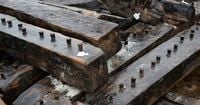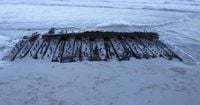When a schoolboy spotted the ribs of a wooden ship poking through the dunes of a remote Scottish beach, he sparked a remarkable journey to uncover its story. The vessel, uncovered in February 2024 on the island of Sanday in Orkney, has now been identified as the Earl of Chatham, a former Royal Navy warship with a storied past spanning battles, whaling expeditions, and a dramatic wreck.
The discovery came after a violent storm stripped away the sands that had protected the timbers for centuries. Locals quickly mobilized, using tractors and trailers to haul approximately 12 tons of oak timbers off the beach, igniting a wave of community enthusiasm and historical curiosity. Sanday, a rugged island off Scotland’s northern tip, is known as "the cradle of shipwrecks in Scotland," with around 270 recorded wrecks since the 15th century. Yet the community’s hospitality toward stranded sailors has been equally renowned.
Ben Saunders, senior marine archaeologist at Wessex Archaeology, a charity involved in the investigation, described the vessel as "a lucky ship," despite its wrecked fate. "All 56 crew members survived," he noted, underscoring the ship’s remarkable history of endurance and fortune.
Scientific analysis played a crucial role in the identification process. Experts from Dendrochronicle performed dendrochronology, a method that dates wood by examining tree rings. This revealed that the ship’s timbers originated from southern England in the mid-18th century, aligning with a period when detailed naval records began to be meticulously kept.
With this data, archaeologists and local historians sifted through archives and community records, narrowing down candidates through a process of elimination. The ship was identified as the Earl of Chatham, formerly HMS Hind, a sixth-rate 24-gun frigate built in Chichester in 1749. HMS Hind had a distinguished military career, participating in key sieges during the 1750s, including Louisbourg and Quebec, pivotal battles in Britain’s struggle for control over Canada.
During the American Revolutionary War in the late 1770s, HMS Hind served as a convoy escort amid Britain’s efforts to maintain its American colonies. After decades of service, the ship was decommissioned and sold in 1784, receiving a new lease on life as the Earl of Chatham, a 500-ton whaling vessel operating in the Arctic. This practice of converting sturdy naval ships into whalers was common, as their strong build was ideal for navigating icy waters.
In the late 18th century, whale oil was a vital commodity fueling the Industrial Revolution, used for lubricating machinery, softening textiles, and lighting streets. The Earl of Chatham completed four whaling seasons in the Arctic before meeting its end in March 1788 in the Bay of Lopness, near Sanday. Despite the harsh weather that caused the wreck, all aboard survived, a testament to the vessel’s resilience and the crew’s skill.
The timbers are now preserved in a freshwater tank at the Sanday Heritage Centre, funded by the National Heritage Memorial Fund. This conservation method prevents the wood from drying out and deteriorating after centuries underwater. Visitors to the centre can learn about the ship’s history and the island’s rich maritime heritage.
The project was a true community effort, with volunteers like Sylvia Thorne and Ruth Peace playing key roles in research and preservation. Thorne reflected on the communal spirit, saying, "Quite a few people are really getting interested in it and becoming experts." Peace added, "One of the biggest things I've got out of this project is realizing how much the past in Sanday is just constantly with you — either visible or just under the surface."
Historic Environment Scotland (HES) also supported the research, with Alison Turnbull, director of external relations and partnerships at HES, emphasizing the importance of community involvement. "Communities hold the keys to their own heritage," she said. "It is our job to empower communities to make these discoveries and be able to tell the story of their historic environment."
Nick Hewitt, culture team manager for Orkney Islands Council, praised the collaborative effort, noting it as "a wonderful team effort so far between many and one we’re proud to have been a part of, and will continue to be as we support the Sanday community explore the future possibilities for their wreck."
The uncovering of the Earl of Chatham also highlights the growing impact of climate change on coastal archaeology. Increased storminess and shifting wind patterns have exposed the wreck, which had been buried beneath protective sands. Experts warn that as climate change accelerates, more such discoveries may come to light, reshaping our understanding of maritime history.
Ben Saunders remarked on the unique combination of science and community passion that made this discovery possible. "It is thanks to our dedicated team of community researchers and the evidence they have gathered that means we have been able to identify the Sanday Wreck with a reasonable degree of confidence," he said. "Throughout this project, we have learned so much about the wreck, but also about the community in Sanday in the 1780s."
For the people of Sanday, the shipwreck is more than just a relic; it’s a tangible link to their island’s maritime past and a source of pride. The story of the Earl of Chatham, from its naval battles to its Arctic whaling voyages and final resting place on Sanday’s shores, serves as a vivid reminder of the sea’s enduring influence on this small community.





